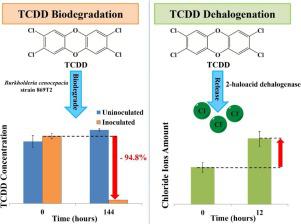Journal of Hazardous Materials ( IF 13.6 ) Pub Date : 2020-07-03 , DOI: 10.1016/j.jhazmat.2020.123347 Bao-Anh Thi Nguyen , Ju-Liang Hsieh , Shou-Chen Lo , Sui-Yuan Wang , Chun-Hsiung Hung , Eugene Huang , Shih-Hsun Hung , Wei-Chih Chin , Chieh-Chen Huang

|
Dioxin compounds are persistent carcinogenic byproducts of anthropogenic activities such as waste combustion and other industrial activities. The ubiquitous distribution of dioxins is global concerns these days. Among of recent techniques, bioremediation, an eco-friendly and cost-effective technology, uses bacteria or fungi to detoxify in dioxins; however, not many bacteria can degrade the most toxic dioxin congener 2,3,7,8-tetrachlorinated dibenzo-p-dioxin (TCDD). In this study, the endophytic bacterium Burkholderia cenocapacia 869T2 was capable of TCDD degradation by nearly 95% after one-week of an aerobic incubation. Through transcriptomic analysis of the strain 869T2 at 6 -h and 12 -h TCDD exposure, a number of catabolic genes involved in dioxin metabolism were detected with high gene expressions in the presence of TCDD. The transcriptome data also indicated that B. cenocepacia strain 869T2 metabolized the dioxin compounds from an early phase (at 6 hours) of the incubation, and the initial outline for a general dioxin degradation pathway were proposed. One of the catabolic genes, L-2-haloacid dehalogenase (2-HAD) was cloned to investigate its contribution in dioxin dehalogenation. By detecting the increasing concentration of chloride ions released from TCDD, our results indicated that the dehalogenase played a crucial role in dehalogenation of dioxin in the aerobic condition.
中文翻译:

Burkholderia cenocepacia菌株869T2对二恶英的生物降解作用:2-卤代酸脱卤酶的作用
二恶英化合物是人为活动(如废物燃烧和其他工业活动)的持久致癌副产物。如今,二恶英的无处不在是全球关注的问题。在最新技术中,生物修复是一种生态友好且具有成本效益的技术,它利用细菌或真菌对二恶英进行解毒。但是,没有多少细菌能够降解毒性最高的二恶英同系物2,3,7,8-四氯二苯并-p-二恶英(TCDD)。在这项研究中,内生细菌伯克霍尔德氏菌需氧培养一周后,869T2能够将TCDD降解近95%。通过在6 h和12 h TCDD暴露时对菌株869T2进行转录组分析,在TCDD存在的情况下,以高基因表达检测到许多参与二恶英代谢的分解代谢基因。转录组数据还表明,新孢双歧杆菌菌株869T2在培养的早期阶段(6小时)代谢了二恶英化合物,并提出了一般的二恶英降解途径的初步概述。克隆了分解代谢基因之一的L-2-卤酸脱卤酶(2-HAD),以研究其在二恶英脱卤中的作用。通过检测从TCDD释放的氯离子浓度的增加,我们的结果表明脱氧酶在有氧条件下对二恶英脱卤起关键作用。



























 京公网安备 11010802027423号
京公网安备 11010802027423号